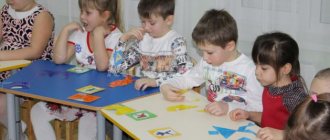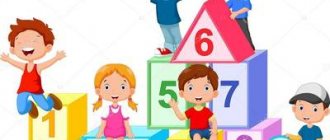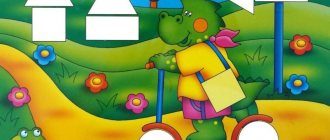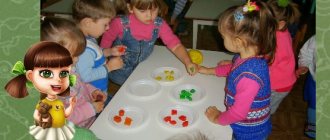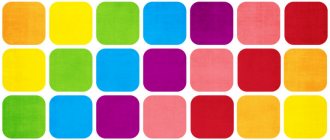A chest of useful things (we study colors and shapes)
Not only do you learn colors with your child, but you also develop fine motor skills through counting. Hammers - and color, fine motor skills and coordination of movements, counting, you can play “find a couple”.
Mushrooms on a stand.
Mushrooms are sorted by color (5 colors), by size (3 sizes), and by the pattern on the caps. So, we count, remember the colors, distinguish more or less equal ones, order, insert a stick. Rod cylinders. We study colors, develop fine motor skills, count to 25, and study the concepts of “big-small-medium”.
"What is color?"
This manual will introduce your child to colors such as red, blue, green, yellow, orange. The images are bright, without unnecessary details, one-color and 4 two-color images. There is a main page where advice is given on working with the book, and various games are offered to develop a child’s color perception. All paintings are cut out and laminated (sealed with tape). At first I just laid out a few images in front of my daughter, naming the colors and telling them what color there was, and after a year they were completely engaged in them, choosing all the images of red, etc., arranged in piles of color. The book includes a cardboard insert - a game: a large multi-colored flower on a white background (primary colors) and 8 colored squares depicting a flower and a butterfly, which can be placed on a petal of the same color.
"Square and Circle"
Thanks to the book, the child learns geometric shapes (circle, square, oval, triangle), colors, and also learns to apply them in the right place on the image. I made this instruction reusable and glued the pages and figures together with tape. For the figures, we glued them to the back of the squares with double-sided tape and received a manual with reusable stickers. The main page provides examples of educational game actions with cubes, pyramids, etc. Recommendations are given on what toys to buy for a child in order to develop the perception of color, size and shape.
"Shape, color."
Thanks to the characters in the fairy tale “Ryaba Hen” (the book contains this particular fairy tale from beginning to end), the child will know the geometric shapes (triangle, square, oval, semi-oval) that must be attached to the corresponding element in the photo. We did not consider this book as a work of fiction; we read fairy tales in a worthy collection. The purpose of this manual is to study geometric shapes, colors, and develop logical thinking.
"Color, shape." This manual will introduce your child to geometric shapes (triangle, circle, square), and you will also be able to repeat the colors and concepts of big and small. My daughter loves to complement images with missing geometric shapes.
The cardboard inlay contains a geometric lot with game options presented on the main page:
| 1 | Find all the triangles (squares, ovals, circles) between the shapes). |
| 2 | Show the largest triangle (square, oval, circle). |
| 3 | Show the smallest triangle (etc.). |
| 4 | Arrange the shapes in descending order: place the largest circle first, then the smallest, then the smallest. |
| 5 | Find all the red shapes (blue, yellow. |
| 6 | Build a yellow house with a red roof from the figures. |
| 7 | Build a pyramid of circles (etc.). |
Well, stick it on yourself, how would you do without it)))
"Complete the mosaic."
Learning about color and shape and developing fine motor skills.
"Animals. Geometric figures".
"Color images".
We guess from the silhouette what is depicted, look for the desired sticker and play with color.
GAMES WITH GEOMETRIC SHAPES.
It is important to teach your child to perceive and distinguish the shapes of objects and remember their names. To do this, the child studies the shape of an object with his hands and eyes and applies the acquired knowledge to solve a specific problem (for example, to select suitable geometric shapes for a slot of the appropriate shape). As a result of purposeful games, the child remembers the standards of geometric shapes and their names. Round is not round. Place round shaped objects in a tight bag (wheel, plastic plate, pyramid rings, teething ring, etc.) and other objects (matryoshka doll, cube, book, bar of soap, etc.). The child needs to get only round objects without looking. Or take any object and say whether it is round or not. “Recognize the figure” Prepare paired volumetric geometric figures: cube, ball, parallelepiped, cylinder, cone, etc. One set of figures is folded into a bag, the second is placed on the table. Show any figurine on the table and ask the child to take it out of the bag. Name the resulting figure: “parallelepiped”, “cylinder”.
“What is blue”
The board game “Gnomes and Houses” will introduce your child to flowers. Contains 7 large and 42 small lotteries with colorful images. And instructions, where there are 5 game options (1. Twin gnomes. 2. Collect all the cars / houses / flowers, etc. 3. Help the gnomes collect their pictures 4. Cars on the road (starting with the rules of this game), you can “play” cards with other images) 5. Lotto Plus for older children additional games are offered: “extra quarter” (the game develops observation and thinking) and “Who can collect the images faster” (we will develop attention and motor skills).
What else to read: Didactic games for introducing preschoolers to the world around them
Magic magnets "Funny figures". There are no stickers on each page; the child is asked to find them among the magnets.
"Colors and Shapes"
To conduct a lesson, you need to cut out and invite the child to put the eggs in a chicken nest, dress the girls in dresses, and so on. : Build a tower according to the diagram. We really liked the sorting tasks: by size and shape (arrange watermelons and cones with nuts).
GAMES WITH GEOMETRIC FIGURES.
By the age of three, a child can already group objects according to shape. And now you need to introduce the child more specifically to each geometric figure, teach him to identify and name the shape of objects. Gradually begin to get acquainted with the figures and move on to the next one after the child has already memorized it well. You can study geometric shapes using the proposed games. Just try to make lessons with your child fun and interesting! Play, don't teach!
"Geometric figures"
GEOMETRIC APPLICATION FOR CHILDREN FROM 1.5 – 2 YEARS OLD.
All types of structures are very useful for the multi-vector development of a child’s thinking. When constructing, for example, such types of thinking develop as: combinatorial, spatial, abstract, figurative. The design can be voluminous or flat. Aerial photography includes mosaic and appliqué lessons. Geometric applique is a special type of applique. When practicing geometric applications, the image consists of simple geometric shapes. Imagine how much a child needs to understand, how much he needs to develop his thinking in order to understand, for example, that the image of a house can consist of a square with a triangle, or you can learn to fold a snowman from three circles, or a ladder from rectangles of different lengths. A small child does not yet know how to perform appliqué in the traditional form - cut out parts from colored paper and glue them to the base. Therefore, for practice it is better to use pre-prepared figures. These figures are used in more than one lesson: without attaching them to a base, the child will place various images of them on his children's table or on a large sheet of cardboard.
And we have block albums!
Cuisenaire colored sticks.
And the album!
PLAY WITH QUEENER STICKS!
Belgian primary school teacher George Cuisiner (1891–1976) developed a universal teaching material for developing children's mathematical skills. In 1952 he published the book "Numeri e Colori", dedicated to his textbook. Kusener's sticks are counting sticks, also called "colored numbers", colored sticks, colored numbers, colored rulers. The set contains prismatic sticks in 10 different colors and lengths from 1 to 10 cm. Sticks of the same length are made in one color and represent a certain number. The longer the stick, the greater the value of the number it expresses.
Products vary in quantity, color and material (wood or plastic). To start, you can use a more simplified set of 116 sticks. Contains 25 white, 20 pink, 16 blue, 12 red, 10 yellow, 9 purple, 8 black, 7 burgundy, 5 blue and 4 orange sticks. The Cuisenaire manual is intended primarily for children aged 1 to 7 years.
